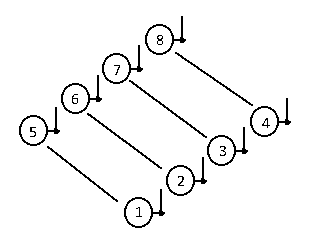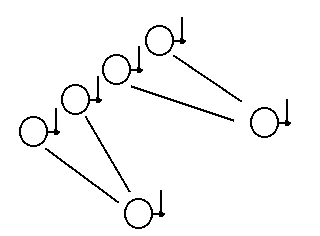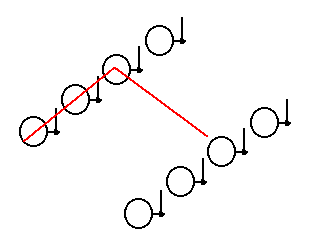Last week’s entry ended in me trying to decide whether to go with a row system or a threat system for mitigating damage in team battles. But neither solution really felt right. In the case of a row system you end up with characters with stats built for team situations being completely overpowered in non-team situations, and in the case of the threat system you also ended up with abilities that are useless in 1v1 situations. And that core problem is what the solution was born from: the need to make a primarily 1v1 system still work in 4v4 situations.
 This is the lane system. It’s quite simple. When two combatants are opposite each other, they form a lane (the lines in the diagram). Most attacks can only target enemies in a character’s lane. So in this case 1 can only attack 5, 2 can only attack 6, etc. Effectively a 4v4 becomes more like 4 1v1s occurring at the same time, so the possible damage range for each character remains about the same as it would be in a 1v1. Naturally allies can still target one another freely, and the extremely valuable attack-all abilities will still target all enemies regardless of lane.
This is the lane system. It’s quite simple. When two combatants are opposite each other, they form a lane (the lines in the diagram). Most attacks can only target enemies in a character’s lane. So in this case 1 can only attack 5, 2 can only attack 6, etc. Effectively a 4v4 becomes more like 4 1v1s occurring at the same time, so the possible damage range for each character remains about the same as it would be in a 1v1. Naturally allies can still target one another freely, and the extremely valuable attack-all abilities will still target all enemies regardless of lane.
In the case of unbalanced teams, multiple lanes get formed:
Most lane attacks are still single target, so the disadvantaged player gets to choose which enemy they want to attack. There were ideas to still only create one lane in cases like these (making the second character on the 2 side just be support), but it was decided the majority deserves an advantage in these situations. In some rare circumstances this can actually be advantageous to the minority side by exposing a weaker character to them, but the double damage they end up receiving still makes this a minor advantage.
With this much positioning being introduced to the system it only made sense to introduce multi-target attacks that are directional. For instance, “attack all enemies left of your lane”:
This creates situations where the far left and far right slots become more valuable than other slots. Since position is now important, I had to start introducing abilities to let characters move around. There’s a whole lot of flavors available: move left/right of my current slot, move to the slot of a certain enemy, move an enemy into my lane, swap my slot with a specific ally, etc.
From this roles start to emerge in battle. Tanks want to keep damage dealing characters aligned with them instead of fragile allies. Fragile healers want to keep their slot away from the damage dealing characters. Damage dealers want high maneuverability so they can align themselves with weaker characters. Attack all characters want the highly valuable far left or far right slots, the enemy team wants to keep them away from those slots, etc.
For the most part I think this is awesome and adds just the right amount of depth that the game was missing. It doesn’t really slow down pacing since position changing abilities will have the same rule as everything else in the game: “you can do something special, but always deal damage at the same time!”. What I worry about is how the battle system’s turns operate: everyone picks their action, and then the turn happens. This can create some extremely hard to follow position changing depending on the turn order and the enemy team’s influence. Changing the turn order to be one player at a time would fix this problem, but it would also cripple the game’s pacing so it’s not really a viable option. For the time being I plan on going full-tilt with the system and seeing how confusing it gets in testing. If it becomes too much, there are probably rules that can be imposed to make it less confusing (no moving enemies, only 1 move per turn, etc)
You might recall the threat system having the problem of introducing mechanics for team battles that become irrelevant in solo combat. On the surface the positional system sounds like it has the same problem. Who cares where you are when there’s only one enemy? But there’s actually lots of cool stuff that can be done with it. We could place bombs on the battlefield, if you swap a bomb directly opposite an enemy’s slot, then it would explode on them. Another option that is also beneficial to team battles would be to have status effects that are bound to specific slots. Suddenly being able to move to the right becomes very important when it means getting out of poison or into a defense bonus! So as it turns out the positional system can add just as much to 1v1 as it does to 4v4.
I was reluctant to add another system to the game this late in development. But the reality is that this fixes the problem. Not only does it fix the problem, but it also adds exactly the right amount of extra depth that I was looking to add to battles. So I think it’s worth it. In that general vein, I’ve started to go into more of a crunch schedule so I can get this thing done already. The first fruit of this schedule is that I’ve already implemented the system I just outlined above in the same week that I came up with the design of it. The 1v1 enhancing features I described haven’t been implemented yet, but my current plan is to build co-op classes and battle encounters around the new system in order to test it out. If it works well in co-op, then I’ll add the 1v1 features and rebuild PVP around it. So that’s my goal for this week. See you then!

